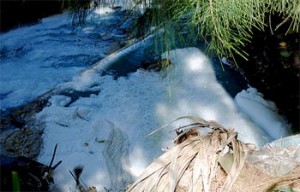Rivers and Streams in Alamar

By Erasmo Calzadilla (photos: Irina Echarry)
HAVANA TIMES — Havana’s Alamar neighborhood, like Babylon, lies between two rivers: the Cojimar and the Bacuranao.
If we go by its smell and appearance, the Cojimar River is extremely sick. Hundreds of sewers discharge their sewage into its bed. In addition to that, there’s the Suchel Company. This cosmetics firm — associated with the fragrance, good hygiene and cleanliness — makes a magnificent contribution of toxic wastes.
The fishermen of Cojimar, dairies whose cattle graze along the banks and various farms are all near the river, with each involved with products that end up on our plates.
The “steamy” grove

Following the river bed that runs toward the mouth, just at the entrance of the Alamar neighborhood, there’s a pretty grove in which the city’s biggest gay “hook-up” area is located. It’s curious how nature insists on mixing pee and poop (from the river in this case) with eroticism and sexuality.
If we were to disregard the waters of Cojimar near this site, it’s actually a pretty place – dark and full of vines and birds. On the ground you’d find many used condoms, empty rum bottles and sometimes intoxicating “shrooms” growing there, and you can tell that Bacchus roams the area, but what cowards have taken his Maenads from there?
No warnings

A few miles beyond, the river vomits up all the debris that it has swallowed. In the summer, the beaches around the mouth are full of swimmers, though there are no signs warning people about the water quality.
Now I should say something about the Bacuranao River, but I still haven’t explored it yet – so I’ll discuss the smaller waterways.
Like a medieval village, Alamar is crisscrossed by streaming flows of wastewater. Those that aren’t open sewers converge somewhere near the coast and from there dump into the sea.
For some reason related to their feeding, fish love to be around the putrid parts of the coast where filth collects, and behind the fish come the fishermen. In turn, innocently enough, then you come along to buy a fillet, not knowing what a treat you’re really getting.
Another swimming area, “Russian Beach,” is precisely in the direction that the sea’s current carries sewage discharge. There’s no indication of this, except an occasional septic-tank-like smell that warns swimmers.
Conclusion: If Cuba is an island surrounded by water, Alamar is a community surrounded by contaminated water.
Click on the thumbnails below to view all the photos in this gallery. On your PC or laptop, you can use the directional arrows on the keyboard to move within the gallery. On cell phones use the keys on the screen.





















Wow. A photo really is worth a thousand words. From these photos it appears that the Alamar neighbourhood in Havana lacks primary – let alone tertiary – sewage treatment, there are no recycling programs (including refundable deposits for containers), there appears to be little or no food safety testing, and area residents are being exposed to all sorts of unnecessary public health risks.
In former Soviet bloc countries like East Germany, independent environmental activism was one of the key contributors to the fall of their dictatorship. Looks like there is all sorts of room for environmental activism in Cuba.